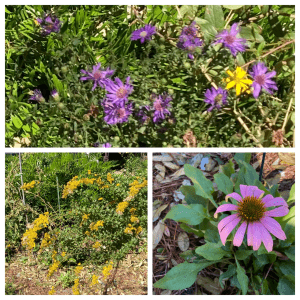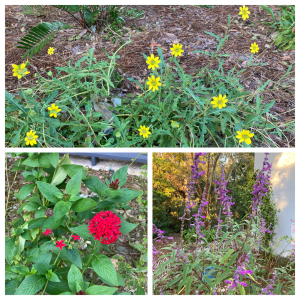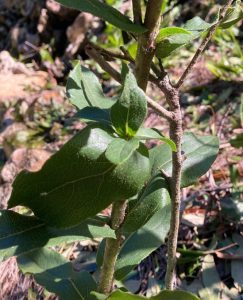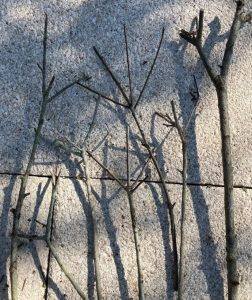In our area of Polk County, Hurricane Ian produced Category 1 winds and associated rainfall. Local flooding and loss of power were experienced by many. And yet there is hope in a garden, and one local garden filled with pollinator plants offered a bit of cheer and hope on the morning after Ian’s visitation!
The following autumn-blooming plants in this garden survived the storm; not surprisingly many are Florida native shrubs and wildflowers, while others are Florida-Friendly non-native plants. Happily, it did not take long for butterflies and bees (and a hummingbird) to resume their daily nourishment.
NATIVE POLLINATOR PLANTS:

Rosinweed is such a reliable wildflower, blooming from spring through fall and sporadically during mild winters as well. Because of its height (up to 3-4 foot stems), some individual plants were leaning quite a bit from the hurricane winds. In the morning, they were easily propped up to vertical positions by using nature’s “crutches”, and were still blooming (See how to make your own nature’s crutch at the end of this article.)
Goldenrod. Chapman’s Goldenrod was already staked up. It tossed and turned during the storm, but in the morning was erect and still holding onto golden blooms!
Stoke’s Aster and Purple Coneflower. These perennial wildflowers were already decreasing seasonal bloom, but the foliage on all these plants was just fine and many of these plants still held onto existing blooms and new flower buds.
Georgia Aster (native). The deep purple flowers of this fall bloomer contrast beautifully with the bright yellow of nearby wildflowers. This plant did lean over quite a bit after the storm but was easily propped back up and is still looking fine on day 5 after the hurricane.
Greeneyes. What hurricane?
Other native pollinator plants that survived: Firebush (this large shrub took a beating, but with a bit of pruning of damaged branches, is recovering by day 5. In fact, a hummingbird was observed visiting the firebush the morning after the hurricane! Other survivors: Georgia Calamint, Simpson’s Stopper, Sparkleberry, Rusty Lyonia, Silver Saw Palmetto (one inground and one in large container), Native Petunia and Cottony Goldenaster.
Native butterfly host plants that survived: Native milkweeds: Aquatic, Swamp and Whorled; Frog Fruit, Corkystem Passionvine, Privet Senna
NON-NATIVE FLORIDA-FRIENDLY POLLINATOR PLANTS:
Heirloom Red Pentas. This large shrub with brilliant red flowers is a butterfly magnet! In this yard, two of four had fallen over and need propping up as well as adding soil back to the resulting soil void (see end of article). They were watered back in, and on day 5 are looking healthy and blooming still.
Dwarf Mexican Sage and Mystic Spires Salvia. These two species of Florida-Friendly salvia did extremely well. Both were in containers and were laid on their sides next to a hedge.
Red Rocket Firecracker Plant: The long arching stems with their bright red multiple flowers were standing tall and strong on the morning after Ian!
TIPS ON ADDRESSING SMALL STORM-DAMAGED POLLINATOR PLANTS:
If a plant has been partially uprooted, you will note that there is probably a void of soil around the stem especially on the opposite side of the plant’s leaning direction. Try to prop up the plant in a vertical position, then add soil to the areas of void. To avoid air pockets, tap the soil in with a spade or small shovel. Do not create compaction of your soil by stomping on the ground, and do not add soil above the natural soil line. Water the plant and observe in the coming days.
If plants appear to have damage to blooms or foliage, prune away the damaged material. Also consider dead-heading any spent blooms to reduce weight on the end of stems while the plant recovers from stress.
As you remove hurricane debris from your garden, make sure to clear heavy leaf build-up away from your plants. Monitor all plants in the upcoming days and weeks for damage that may not be evident yet.
How to make “nature’s crutches”: This is an easy and cost-free way to prop up leaning plants. It is especially good for small plants, such as wildflowers. From the many dead twigs and small branches that now adorn your yard, select several that have multiple branching above a straight stem. Cut into sizes you need and gently place the straight part of the stick next to your plant. The plant’s stem will nestle between the multiple branching for support.

This article was written by Master Gardener Volunteer Molly Griner under supervision of the Master Gardener Volunteer Coordinator and Residential Horticulture Agent Anne Yasalonis.
For more information, contact UF/IFAS Extension Polk County at (863) 519-1041 or visit us online at http://sfyl.ifas.ufl.edu/polk. The Plant Clinic is open Monday-Friday, 9:00 am-4:00 pm to answer your gardening and landscaping questions. Give us a call or email us at polkmg@ifas.ufl.edu.
If you are not in Polk County, Contact your local UF/IFAS Extension Master Gardener Volunteer Plant Clinic.
The Florida Master Gardener Volunteer Program is a volunteer-driven program that benefits UF/IFAS Extension and the citizens of Florida. The program extends the vision of the University of Florida/Institute of Food and Agricultural Sciences, all the while protecting and sustaining natural resources and environmental systems, enhancing the development of human resources, and improving the quality of human life through the development of knowledge in agricultural, human and natural resources and making that knowledge accessible.
An Equal Opportunity Institution.
 0
0
